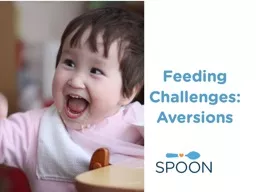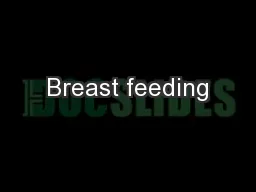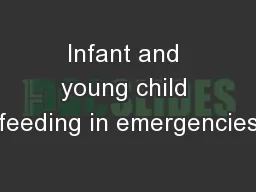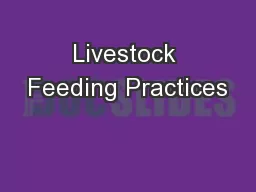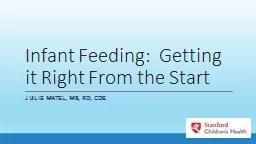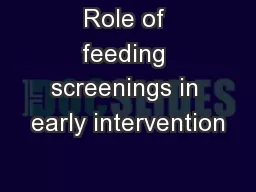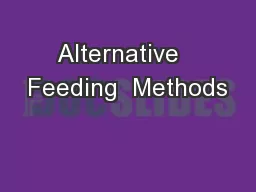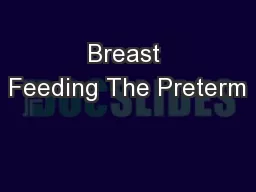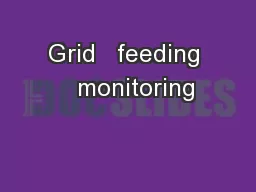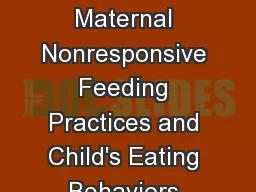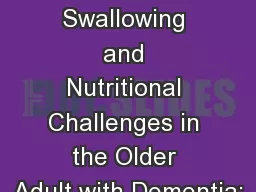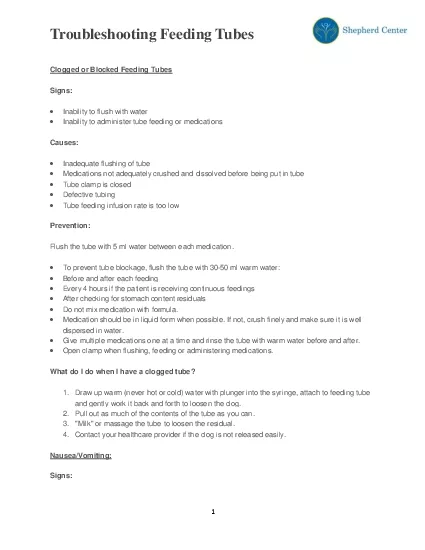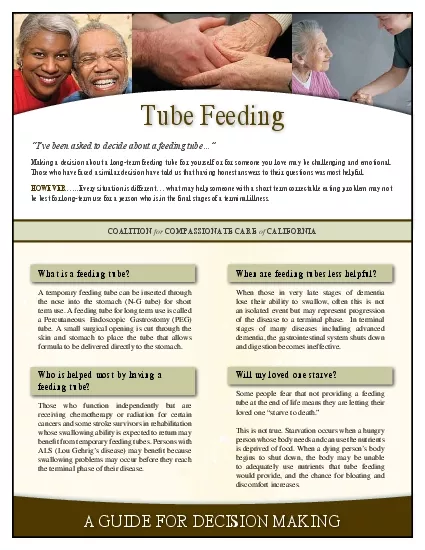PPT-Feeding Challenges: Aversions
Author : tatyana-admore | Published Date : 2020-04-10
2018 SPOON Learning Objectives Explain what a feeding aversion is Name 3 reasons an infant or child might develop feeding aversion Recall 2 signs a child might
Presentation Embed Code
Download Presentation
Download Presentation The PPT/PDF document " Feeding Challenges: Aversions" is the property of its rightful owner. Permission is granted to download and print the materials on this website for personal, non-commercial use only, and to display it on your personal computer provided you do not modify the materials and that you retain all copyright notices contained in the materials. By downloading content from our website, you accept the terms of this agreement.
Feeding Challenges: Aversions: Transcript
2018 SPOON Learning Objectives Explain what a feeding aversion is Name 3 reasons an infant or child might develop feeding aversion Recall 2 signs a child might have a feeding aversion Understand what to do if you suspect a child has a feeding aversion . Nourishing your child & building immunity. .. . Benefits of Breast Feeding. Breast milk provides optimum nutrition for infants.. Breast milk has the perfect combination of, vitamins, proteins and fats.. prepared by. :. . Dr.KHALID H.SALIH. . If we could give every individual the right amount of nourishment and exercise, not too little and not too much, we would have found the safest way to health. . Why IYCF-E important for survival of children in the Syria crisis. Key messages. Supporting and protecting optimal infant and young child feeding in the Syria crisis is an . essential. intervention to save children’s lives.. By: Mariah Gumfory, Arlene Barrett, Haley Vrazel, & Dennis Bratton. Objectives. Explain need to have a feed plan.. Define some of the feed types that are used.. List the different feeding practices used between beef and dairy cattle.. I. What is the main task of the pastor/shepherd in relation to the flock?. The main task of the pastor/shepherd is feeding the flock in . green pastures. .. A. In the Old Testament. 1. God fed His people (Gen. 48:15).. Julie Matel, MS, RD, CDE. Nutrition for Infants with CF. Should I drink breast milk or formula?. Do I need a high calorie formula?. Does early growth matter?. When can I eat real food?. Evidence-based practice recommendations for nutrition-related management of children and adults with cystic fibrosis and pancreatic insufficiency: results of a systematic review. J Am Diet Assoc. 2008;108:832-839.. Presented by: . S.Lauren. Esparza, . M.Ed. , . Slp. -ccc . . Danielle Boatright, . M.Ed. , . EcSE. . . Sue Kreikemeier, . FrC. Course purpose. This presentation will discuss the implementation of a screening tool to be utilized by team members and professionals other than the Speech Pathologist to determine if further evaluation of feeding skills are necessary for children ages birth to 3 years.. Dr . majid. . kalani. -IUMS-. Shahid. . Akbarabadi. Hos. . Breastfeeding. is the best way of feeding newborn infants. Low. . prevalance. of breastfeeding is a major problem across the globe.. The Right Must Be . Done Right. Dr. . Eisa. Sayed Ahmad . Neonatologist . IBCLC. Breastfeeding is one of the most effective ways to ensure child health and survival.. If every child was breastfed within an hour of birth. . relay. CM-UFD.M33. Presentation STO/ . EPR . Grid. . feeding. . monitoring. . relay. CM-UFD.M33. November 26, 2014. | Slide . 2. © ABB Group. Characteristics. UL approval (in preparation). Multiline, backlit LCD display. Department of Child Health care. Nanjing Maternal and Child Health Hospital. Chunmei. Shi, Min Zhang, . Meiling. Tong. 2016.8.29. Interactive behaviors between caregivers and children . . Sensitive to child’s cues. Considerations in Guiding and Supporting . Decision-Making. Paula A. Sullivan, MS., CCC-SLP, BCS-S. North Florida/South Georgia Veterans Health Administration. Paula.sullivan@va.gov. Decision-Making In the . 1Clogged or Blocked Feeding TubesSignsInability to flush with waterInability to administer tube feeding or medicationsCausesInadequate flushing of tubeMedications not adequately crushed and dissolved C GUDE FOR DECISI MINDevelopment of this brochure was made possible through a grant from the California HealthCare Foundation based in Oakland CaliforniaPhone 916-489-2222 wwwCoalitionCCCorgWhat els
Download Document
Here is the link to download the presentation.
" Feeding Challenges: Aversions"The content belongs to its owner. You may download and print it for personal use, without modification, and keep all copyright notices. By downloading, you agree to these terms.
Related Documents

